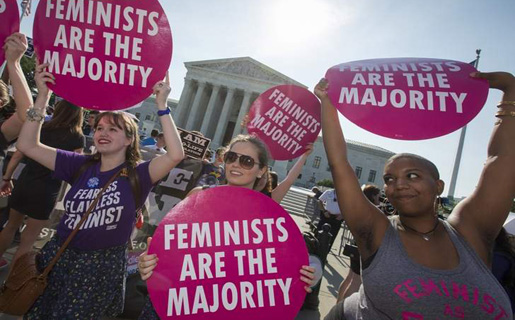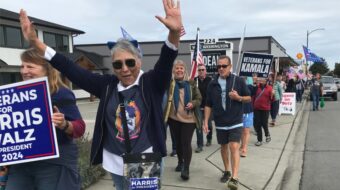
WASHINGTON – Although it ruled against the President’s right to protect undocumented immigrants whose children are American citizens, in the last days of its current session, the Supreme Court took three actions that, for the time being at least, will help keep America on the path toward greater equity and toward full recognition that women have the right to control their own bodies.
The Court struck down a Texas law that would have shut down clinics offering abortions, upheld a university’s right to use affirmative action and let stand a Labor Department decision that two million home health care workers must be covered by federal protections.
Today is the last day of the Court’s 2015 term. It is still flying on one wing because the Senate is refusing to hold hearings on President’s Obama’s nominee to fill the seat vacated by the death of Justice Anton Scalia.
Right to abortions
In 2013, the Texas legislature, which is tightly controlled by right wingers, passed a law imposing extreme regulations on clinics where abortions are offered.
The law covered building features such as corridor width, the swinging motion of doors, floor tiles, parking spaces, elevator size, ventilation, electrical wiring, plumbing, floor tiling and the angle that water flows from drinking fountains.
Texas legislators said the purpose of the law was to protect women and a Texas appeals court upheld that rationale.
The Supreme Court ruled five to three that the purpose of the law was to force the closing down of clinics offering abortions.
The Court said that the law placed an “undue burden on women exercising their constitutional right to end a pregnancy.”
Justice Stephen Breyer, writing for the Court, said that the appeals court that upheld the law was wrong. He noted that courts are required to “consider the burdens a law imposes on abortion access together with the benefits that those laws confer.”
Breyer also wrote that deferring to state legislatures over “questions of medical uncertainty is inconsistent with [the Supreme Court’s] case law.”
Affirmative Action
In a four to three decision, the Supreme Court re-affirmed the educational value of a diverse student body and ruled that the University of Texas’s affirmative action program can stand.
“A university is in large part defined by those intangible qualities which are incapable of objective measurement but which make for greatness,” Justice Anthony Kennedy wrote for the majority. “Considerable deference is owed to a university in defining those intangible characteristics, like student body diversity, that are central to its identity and educational mission.”
Justice Elena Kagan recused herself because of prior work on the issue while at the Department of Justice.
Affirmative action has been used for many years to address past inequities and to help students from disadvantaged minority groups – especially African-Americans and Latinos – to get a better opportunity to gain access to higher education.
The current case was brought on behalf of Abigail Fisher, a white student who alleged she was victimized because of her race when the University of Texas at Austin rejected her application for admission in 2008.
It was clear to the Supreme Court Justices that Fisher’s race had little to do with her being rejected.
About 75 percent of university’s freshmen openings are filled by the state’s Top Ten plan, which guarantees admission to Texas high school students who finish in the top ten percent of their graduating classes. To fill the other 25 percent, the university uses an admissions process that takes race into account, among other things.
The year Fisher applied, 92 percent of the class was filled through the Top Ten program, so competition for the remaining eight percent of openings was particularly stiff. Moreover, Fisher’s high school grade average was about a “C.”
“Although admissions officers can consider race as a positive feature of a minority student’s application, there is no dispute that race is but a ‘factor of a factor’ in the holistic-review calculus,” Kennedy wrote.
This is the second time the Supreme Court has heard the Fisher case. In 2013, the Court ruled seven to one that lower courts should take another look at the University of Texas’s affirmative action program.
The appeals court ruled against Fisher.
Despite the Supreme Court’s ruling, eight states – Arizona, California, Florida, Michigan, Nebraska, New Hampshire, Oklahoma and Washington – have banned public colleges and universities from using affirmative action.
Rights of home health care workers
By refusing to hear a case brought against the Department of Labor (DOL), the Supreme Court has removed all barriers to extending legal protections to some two million home health care workers.
Two years ago, the DOL announced that home health care workers would be covered by federal laws and regulations that, among other things, require workers to be paid federal minimum wage and that they be compensated for overtime work.
At the time, Secretary of Labor Tom Perez told reporters that the long-awaited change “promotes the dignity of work” as well as “the dignity of aging in place.” He added that it meant workers caring for elderly or disabled clients in the home would no longer be treated like “teenage baby sitters performing casual employment,” but rather “treated with dignity, and their hard work is finally rewarded.”
Photo: Activists demonstrate in front of the Supreme Court in Washington, Monday. The Supreme Court Monday struck down Texas’ widely replicated regulation of abortion clinics in the court’s biggest abortion case in nearly a quarter century. | J. Scott Applewhite/AP












Comments